Time Series Analysis#
The only thing we know about the future is that it will be different - Peter Drucker
Time series analysis is a fundamental statistical technique used to analyze data points collected over time. A time series can exhibit multiple components, such as long-term trends, cyclical fluctuations, seasonal variations, and irregular random movements. Understanding these components enables analysts to build accurate predictive models. We explore key concepts in time series analysis, including trend patterns, seasonality, stationarity, autocorrelation, and various statistical models such as autoregressive (AR), moving average (MA), and autoregressive moving average (ARMA) models. We also examine forecasting methods and statistical tests used to assess time series properties.
# By: Terence Lim, 2020-2025 (terence-lim.github.io)
import numpy as np
import pandas as pd
from pandas import DataFrame, Series
import matplotlib.pyplot as plt
import seaborn as sns
from statsmodels.tsa.ar_model import AutoReg, ar_select_order
from statsmodels.graphics.tsaplots import plot_acf, plot_pacf, acf
from statsmodels.tsa.seasonal import seasonal_decompose
from statsmodels.tsa.statespace.sarimax import SARIMAX
from statsmodels.tsa.stattools import grangercausalitytests, adfuller
from statsmodels.tsa.api import VAR
import statsmodels.formula.api as smf
from sklearn.metrics import mean_squared_error
from finds.readers import Alfred
from secret import credentials
VERBOSE = 0
# %matplotlib qt
We retrieve the Industrial Production (IP) total index monthly time series from FRED.
series_id, freq, start = 'IPB50001N', 'ME', 0 # not seasonally adjusted
alf = Alfred(api_key=credentials['fred']['api_key'])
df = alf(series_id, log=1, freq=freq, start=start).dropna()
date_title = f" ({df.index[0]//100}-{df.index[-1]//100})"
df.index = pd.to_datetime(df.index, format='%Y%m%d')
df.index.freq = freq # set index to datetime type with 'M frequency
alf.header(series_id)
'Industrial Production: Total Index'
Seasonality#
A time series can be broken down into three key components:
Trend – Represents long-term movements in the data.
Seasonality – Captures predictable and recurring changes within a specific time frame.
Cyclical – Encompasses longer-term cycles that are influenced by broader economic or structural factors.
If a time series \(Y_t\) exhibits seasonality, its mean can differ across periods, repeating every \(s\) periods (e.g., quarterly with \(s=4\) or monthly with \(s=12\)). Deterministic seasonal effects can be effectively modeled using dummy variables.
## Seasonality Decomposition Plot
result = seasonal_decompose(df, model='add')
fig, ax = plt.subplots(nrows=4, ncols=1, clear=True, figsize=(10, 12))
result.observed.plot(ax=ax[0], title=alf.header(result.observed.name) + date_title,
ylabel=result.observed.name, xlabel='', c='b')
result.trend.plot(ax=ax[1], ylabel='Trend', xlabel='', c='r')
result.seasonal.plot(ax=ax[2], ylabel='Seasonal', xlabel='', c='g')
result.resid.plot(ax=ax[3], ls='', ms=3, marker='.', c='m',
ylabel='Residual', xlabel='')
plt.tight_layout()
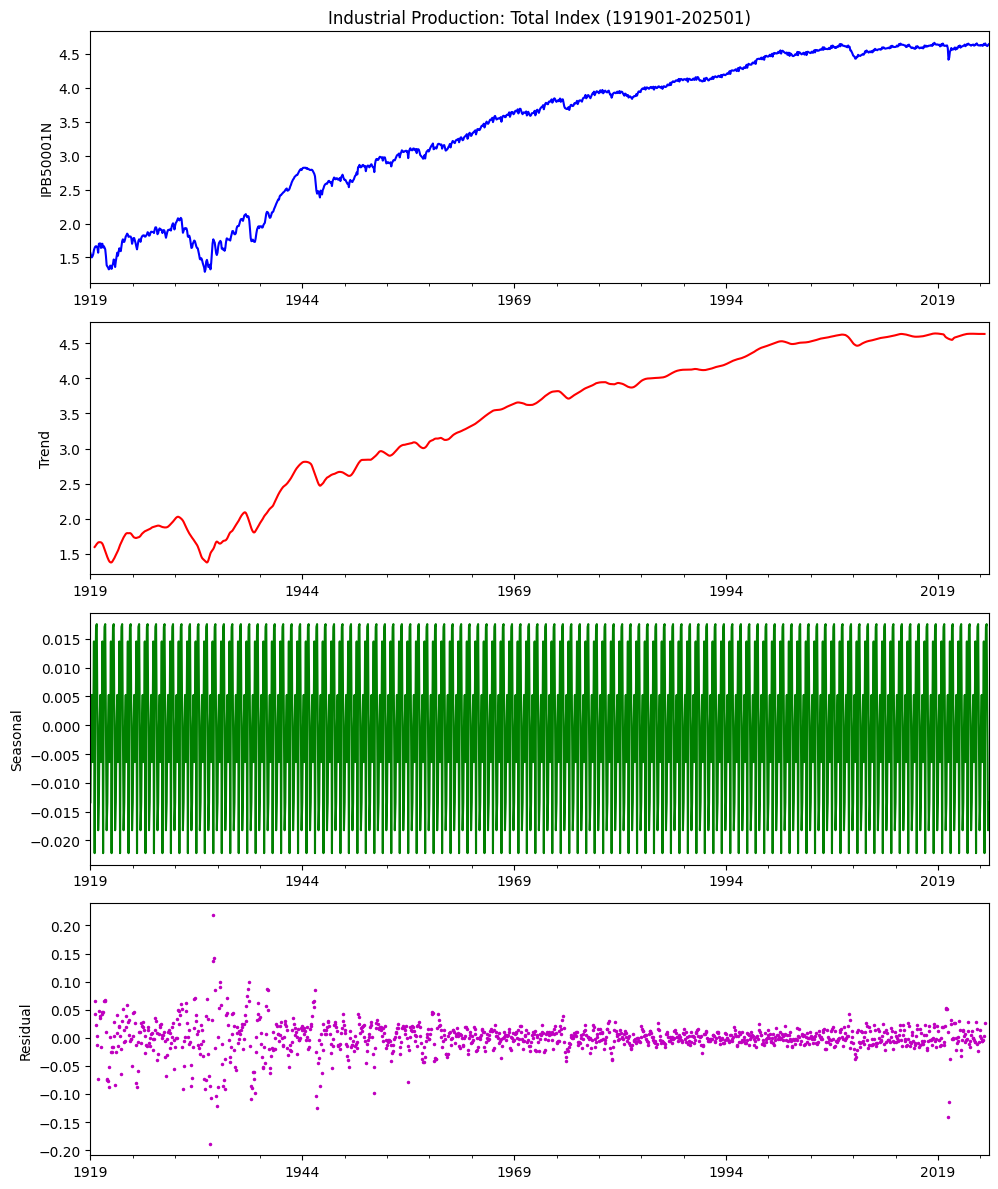
Stationarity#
A time series is considered covariance-stationary if it meets three key conditions:
The mean remains constant over time, i.e., \( E[Y_t] = m \) for all \( t \).
The variance is finite and does not change over time, i.e., \( V[Y_t] = \gamma_0 < \infty \).
The autocovariance depends only on the time lag \( h \) and not on \( t \), i.e., \( Cov[Y_t, Y_{t-h}] = \gamma_h \).
Covariance stationarity depends on the first two moments of a time series. Stationarity is crucial for modeling and forecasting because stationary series exhibit stable statistical properties. The Augmented Dickey-Fuller (ADF) test helps determine whether a time series has a unit root, with the null hypothesis stating that a unit root is present. If the p-value is below a critical threshold, the null hypothesis can be rejected, indicating stationarity.
values = df.diff().dropna().values.squeeze()
adf = adfuller(values)
DataFrame.from_dict({"I(1)": list(adf[:4]) + list(adf[4].values())},
orient='index',
columns=(['Test Statistic', 'p-value', 'Lags Used', 'Obs Used'] +
[f"critical({k})" for k in adf[4].keys()])).round(3)
| Test Statistic | p-value | Lags Used | Obs Used | critical(1%) | critical(5%) | critical(10%) | |
|---|---|---|---|---|---|---|---|
| I(1) | -7.266 | 0.0 | 23 | 1248 | -3.436 | -2.864 | -2.568 |
# Histogram Plot and Kernel Density Estimate
fig, axes = plt.subplots(1, 2, clear=True, figsize=(10,5))
sns.histplot(df.dropna(), bins=30, lw=0, kde=True, ax=axes[0])
axes[0].set_title(f"Density Plot of log({series_id})")
sns.histplot(df.diff().dropna().rename(f"diff log {series_id}"),
bins=30, lw=0, kde=True, ax=axes[1]) #line_kws={"color": "r"}
axes[1].set_title(f"Density Plot of diff log({series_id})")
plt.tight_layout()
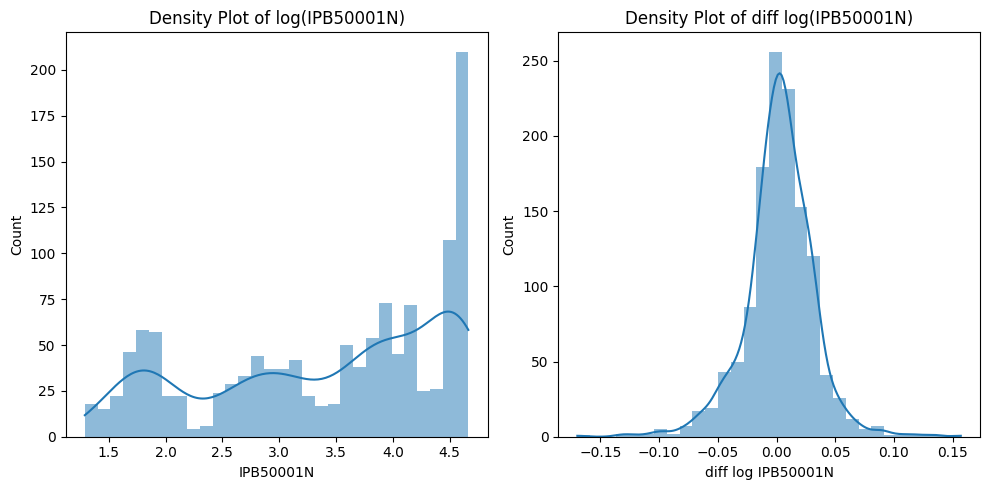
Autocorrelation#
Autocorrelation measures the relationship between time series observations at different points in time. The autocorrelation function (ACF) at lag \( h \) is given by:
$\(
\rho_h = \frac{\gamma_h}{\gamma_0}
\)\(
where \) \gamma_h \( is the autocovariance at lag \) h \(, and \) \gamma_0 $ is the variance.
The partial autocorrelation function (PACF) isolates the direct relationship between observations separated by lag \( h \), removing the influence of intermediate lags (i.e., \(Y_{t-1}, Y_{t-2}, ..., Y_{t-h+1}\)).
values = df.diff().dropna().values.squeeze()
fig, axes = plt.subplots(1, 2, clear=True, figsize=(10,5))
plot_acf(values, lags=35, ax=axes[0])
plot_pacf(values, lags=35, ax=axes[1], method='ywm')
plt.suptitle(alf.header(result.observed.name) + date_title)
plt.tight_layout()
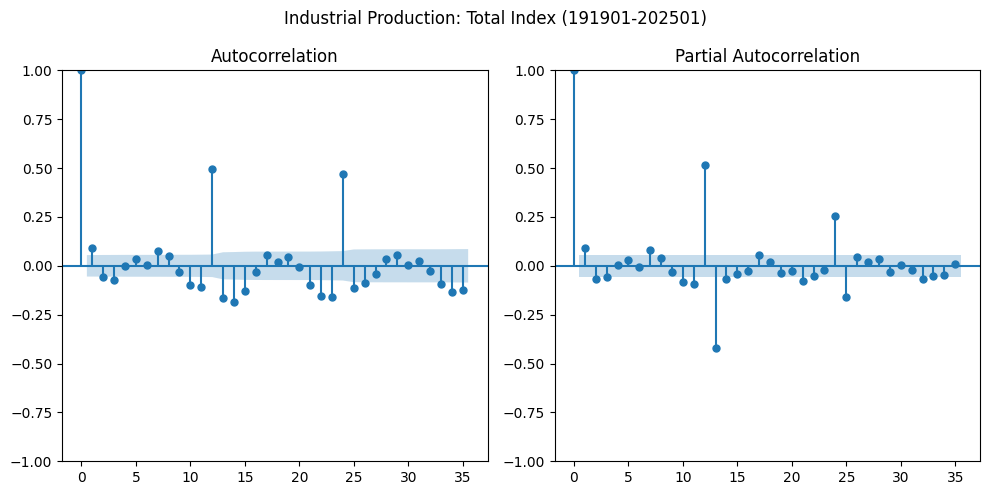
Time Series Models#
Autoregressive (AR) models#
Autoregressive (AR) models describe a time series in terms of its past values. An AR(1) process follows:
$\(
Y_t = \delta + \phi Y_{t-1} + \epsilon_t
\)\(
where \) \delta \( is the intercept, \) \phi \( is the autoregressive coefficient, and \) \epsilon_t $ is white noise.
For a higher-order AR(p) model:
$\(
Y_t = \mu + \phi_1 Y_{t-1} + \phi_2 Y_{t-2} + ... + \phi_p Y_{t-p} + \epsilon_t
\)$
The PACF for an AR process is nonzero only for the first \( p \) lags, while the ACF gradually decays (\(\rho(h) = \phi^{|h|}\))
Moving average (MA) models**#
A moving average model expresses \( Y_t \) as a function of past shocks:
$\(
Y_t = \mu + \theta_1 \epsilon_{t-1} + \epsilon_t
\)\(
An MA(q) model extends this to include \) q \( lags of \) \epsilon \(:
\)\(Y_t = \mu + \epsilon_t + \theta_1 \epsilon_{t-1} + ... + \theta_q \epsilon_{t-q}\)$
The ACF of an MA process is zero for lags greater than \( q \), while the PACF has a more complex structure.
ARMA models#
An ARMA(p, q) model combines AR and MA components. For example, a simple ARMA(1,1) evolves according to: $\( Y_t = \mu + \phi Y_{t-1} + \theta \epsilon_{t-1} + \epsilon_t \)$
The mean of this process is \(\mu = \delta / (1 - \phi)\)
The variance is \(\gamma_0 = \sigma^2(1 + 2\phi \theta + \theta^2)/(1 - \phi^2)\)
An ARMA(1,1) process is covariance-stationary if \(|\phi| <> 1\). The MA coefficient plays no role in determining whether the process is covariance-stationary, because any MA is covariance-stationary as the MA component only affects a single lag of the shock. The AR component, however, affects all lagged shocks and so if \(\phi_1\) is too large, then the time series is not covariance-stationary.
Lag lengths#
Determining the appropriate lag lengths for the AR and MA components (i.e., p and q, respectively) is a key challenge when building an ARMA model. The first step in model building is to inspect the sample autocorrelation and sample PACFs.
The Box-Pierce test statistic is the sum of the squared autocorrelations scaled by the sample size T: $\(Q_{BP} = T\sum_{i=1}^h (\dfrac{T+1}{T-1}) \hat{\rho}_i^2\)$
When the null is true, \(Q_{BP}\) is asymptotically distributed as a \(\chi_h^2\) variable.
The Ljung-Box statistic is a modified version of the Box-Pierce statistic that works better in smaller samples, and is defined as: $\(Q_{LB} = T\sum_{i=1}^h (\dfrac{T+2}{T-i}) \hat{\rho}_i^2\)$
Seasonal component#
Seasonal components can be added to the short-term components of an ARMA(p,q) model, by using lags only at the seasonal frequency. A seasonal ARMA combines these two components into a single specification:
where p and q are the orders of the short-run lag polynomials, \(p_s\) and \(q_s\) represent seasonal lag orders, and \(f\) denotes the seasonal horizon (e.g., every 3 or 12 months with monthly observations).
Unit Roots#
Random walks are most important source of non-stationarity in economic time series. A simple random walk process evolves according to:
Unit roots generalize random walks by adding short-run stationary dynamics to the long-run random walk.
Spurious relationships can occur when non-stationary series are regressed against each other; this produces produces a coefficient estimate that is large and seemingly statistically different from zero when using conventional statistical distributions to obtain the critical values.
Differencing removes unit roots and prevents such misleading results. If \(Y_t\) has a unit root (i.e. has integration order equal to 1), then the difference: \(\Delta Y_t = Y_t - Y_{t-1}\) does not.
SARIMAX model#
The Seasonal AutoRegressive Integrated Moving Average with eXogenous Regressors (SARIMAX) model is denoted:
$\(
(p, d, q) \times (P, D, Q)_s
\)$
where:
\( (p, d, q) \) are the orders of AR, differencing, and MA components.
\( (P, D, Q, s) \) are the seasonal counterparts and periodicity.
split_date = df.index[-12] # train/test split date
# df_train = df.loc[:split_date].dropna()
# Fit a SARIMA(1,1,3) with seasonal order (0, 0, 0, 12)
pdq = (1, 1, 1) #(12, 1, 0)
seasonal_pdqs = (0, 0, 0, 12)
arima = SARIMAX(df, order=pdq, seasonal_order=seasonal_pdqs, trend='c').fit()
fig = arima.plot_diagnostics(figsize=(10, 6), lags=36)
plt.tight_layout()
arima.summary()
RUNNING THE L-BFGS-B CODE
* * *
Machine precision = 2.220D-16
N = 4 M = 10
At X0 0 variables are exactly at the bounds
At iterate 0 f= -2.09476D+00 |proj g|= 3.46166D-01
At iterate 5 f= -2.09484D+00 |proj g|= 2.67321D-02
At iterate 10 f= -2.09486D+00 |proj g|= 1.29274D-01
* * *
Tit = total number of iterations
Tnf = total number of function evaluations
Tnint = total number of segments explored during Cauchy searches
Skip = number of BFGS updates skipped
Nact = number of active bounds at final generalized Cauchy point
Projg = norm of the final projected gradient
F = final function value
* * *
N Tit Tnf Tnint Skip Nact Projg F
4 14 18 1 0 0 8.413D-04 -2.095D+00
F = -2.0948681083990448
CONVERGENCE: REL_REDUCTION_OF_F_<=_FACTR*EPSMCH
This problem is unconstrained.
| Dep. Variable: | IPB50001N | No. Observations: | 1273 |
|---|---|---|---|
| Model: | SARIMAX(1, 1, 1) | Log Likelihood | 2666.767 |
| Date: | Mon, 03 Mar 2025 | AIC | -5325.534 |
| Time: | 10:54:09 | BIC | -5304.941 |
| Sample: | 01-31-1919 | HQIC | -5317.799 |
| - 01-31-2025 | |||
| Covariance Type: | opg |
| coef | std err | z | P>|z| | [0.025 | 0.975] | |
|---|---|---|---|---|---|---|
| intercept | 0.0027 | 0.001 | 2.396 | 0.017 | 0.000 | 0.005 |
| ar.L1 | -0.1167 | 0.223 | -0.524 | 0.600 | -0.553 | 0.320 |
| ma.L1 | 0.2195 | 0.222 | 0.987 | 0.323 | -0.216 | 0.655 |
| sigma2 | 0.0009 | 2.21e-05 | 39.946 | 0.000 | 0.001 | 0.001 |
| Ljung-Box (L1) (Q): | 0.02 | Jarque-Bera (JB): | 563.24 |
|---|---|---|---|
| Prob(Q): | 0.87 | Prob(JB): | 0.00 |
| Heteroskedasticity (H): | 0.31 | Skew: | -0.20 |
| Prob(H) (two-sided): | 0.00 | Kurtosis: | 6.23 |
Warnings:
[1] Covariance matrix calculated using the outer product of gradients (complex-step).
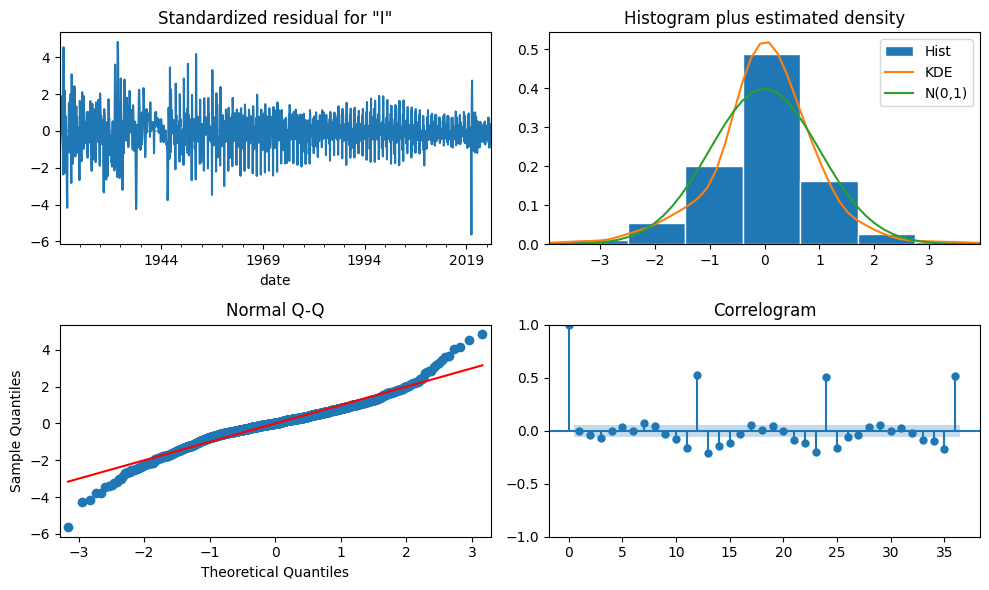
Forecasting#
series_id, start = 'INDPRO', 0
df_all = alf(series_id, log=1, diff=1, start=start).dropna()
df_all.index = pd.to_datetime(df_all.index, format='%Y%m%d')
df_all.index.freq = freq
df_train = df_all[df_all.index <= split_date]
df_test = df_all[df_all.index > split_date]
AR lag order selection#
The most natural measure of fit is the sample variance of the estimated residuals, also known as the Mean Squared Error (MSE) of the model. Unfortunately, choosing a model to minimize MSE also selects a specification that is far too large. The solution to this overfitting problem is to add a penalty to the MSE that increases each time a new parameter is added, employing criteria like Akaike Information Criterion (AIC) and Bayesian Information Criterion (BIC).
AIC is calculated by \(T \ln \hat{\sigma}^2 + 2 k\), where T is the sample size and k is the number of parameters.
BIC alters the penalty and is computed by \(T \ln \hat{\sigma}^2 2 + k \ln T\)
Unlike the AIC, the BIC has a cost per parameter that slowly increases with T. Hence BIC always selects a model that is no larger than the model selected by the AIC (assuming \(\ln T > 2\)), and is a consistent model selection criterion (i.e., the true model is selected as \(T \rightarrow \infty\)).
lags = ar_select_order(df_train, maxlag=36, ic='bic', old_names=False).ar_lags
print('(BIC) lags= ', len(lags), ':', lags)
(BIC) lags= 1 : [1]
# Train final model on train split
model = AutoReg(df_train, lags=lags, old_names=False).fit()
print(model.summary())
AutoReg Model Results
==============================================================================
Dep. Variable: INDPRO No. Observations: 1261
Model: AutoReg(1) Log Likelihood 3366.312
Method: Conditional MLE S.D. of innovations 0.017
Date: Mon, 03 Mar 2025 AIC -6726.625
Time: 10:54:10 BIC -6711.208
Sample: 03-31-1919 HQIC -6720.831
- 02-29-2024
==============================================================================
coef std err z P>|z| [0.025 0.975]
------------------------------------------------------------------------------
const 0.0013 0.000 2.705 0.007 0.000 0.002
INDPRO.L1 0.4859 0.025 19.794 0.000 0.438 0.534
Roots
=============================================================================
Real Imaginary Modulus Frequency
-----------------------------------------------------------------------------
AR.1 2.0581 +0.0000j 2.0581 0.0000
-----------------------------------------------------------------------------
One-step forecast#
One-step forecast predicts \( Y_{T+1} \) using all available data up to time \( T \), including the entire prior history of Y (\(Y_T, Y_{T-1}, ... \)), as well as all values of any other variables that occurred at time T or earlier.
# Observations to predict are from the oos test split
test = AutoReg(df_all, lags=lags, old_names=False)
# Use model params from train split, start predictions from last train row
df_pred = test.predict(model.params, start=df_test.index[0])
mse = mean_squared_error(df_test, df_pred)
#var = np.mean(np.square(df_test - df_train.mean()))
print(f"ST Forecast({len(df_pred)}): rmse={np.sqrt(mse)}")
ST Forecast(11): rmse=0.006247508053669628
fig, ax = plt.subplots(clear=True, num=1, figsize=(10, 6))
df_pred.plot(ax=ax, c='C1', ls='-', marker='o', label='Predicted')
df_test.plot(ax=ax, c='C0', ls=':', marker='*', label='Actual')
ax.legend()
ax.set_title(series_id + " (one-step forecasts)")
ax.set_xlabel('')
plt.tight_layout()
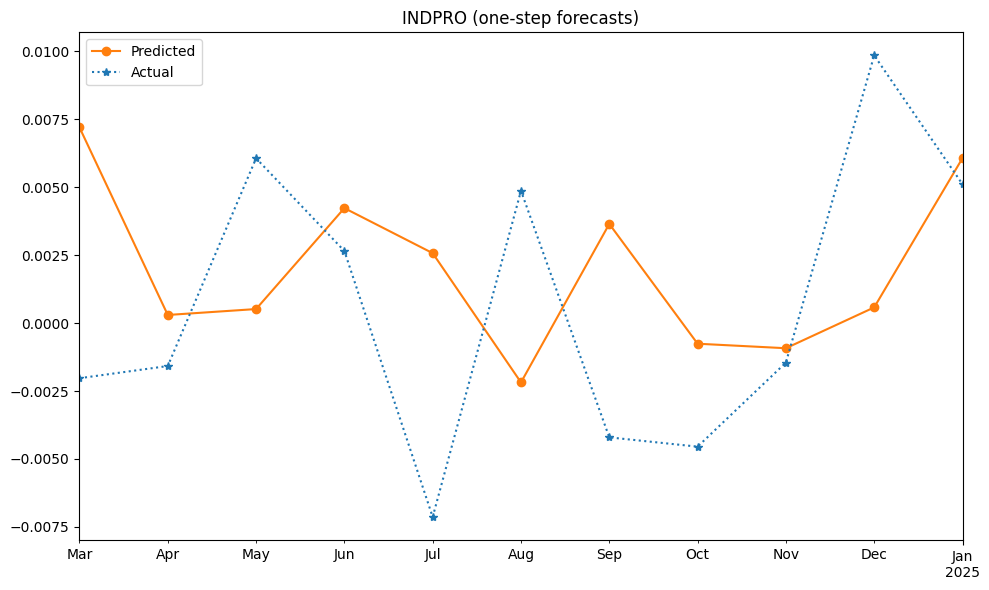
Multi-step forecast#
Multi-step forecasts recursively predict values at future horizons, starting with \(E_T[Y_{T+ 1}]. The forecast at horizon h depends on forecasts from earlier steps (\)E_T[Y_{T+ 1}], …, E_T [Y_{T+ h - 1}]). When these quantities appear in the forecast for period \(T + h\), they are replaced by the forecasts computed for horizons \(1, 2, ... , h - 1\).
# set dynamic=True for multi-step ahead predictions
df_pred = test.predict(model.params, dynamic=True,
start=df_test.index[0], end=df_test.index[-1])
mse = mean_squared_error(df_test, df_pred)
#var = np.mean(np.square(df_test - df_train.mean()))
print(f"Long-term Forecasts: rmse={np.sqrt(mse):.6f}")
fig, ax = plt.subplots(clear=True, num=2, figsize=(10, 6))
df_pred.plot(ax=ax, c='C1', ls='-', marker='o', label='Predicted')
df_test.plot(ax=ax, c='C0', ls=':', marker='*', label='Actual')
ax.legend()
ax.set_title(series_id + " (multi-step forecasts)")
ax.set_xlabel('')
plt.tight_layout()
Long-term Forecasts: rmse=0.006085
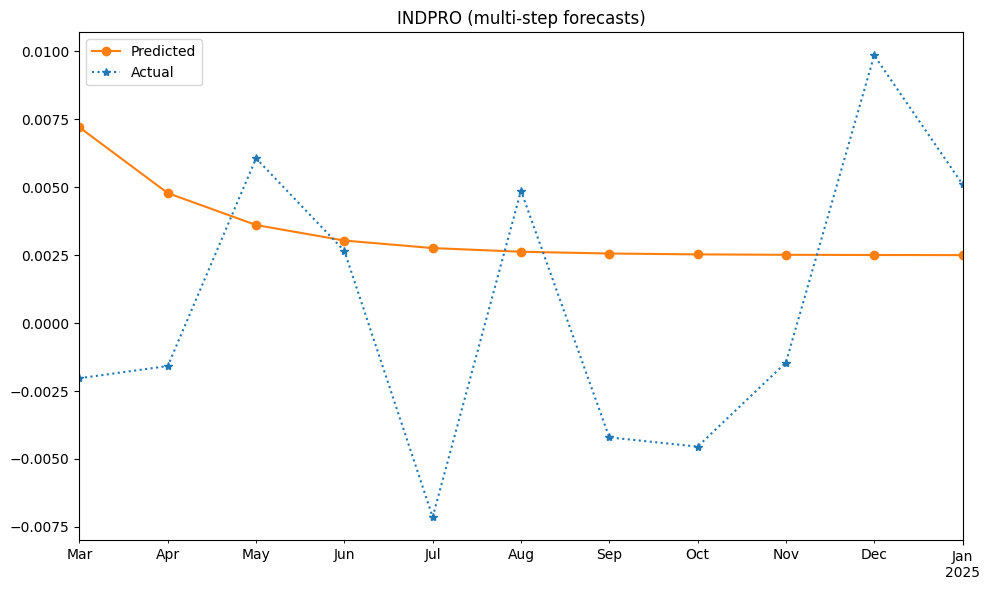
Granger causality#
Granger causality tests whether past values of one time series help predict another.
# Granger Causality: INDPRO vs CPI
variables = ['INDPRO', 'CPIAUCSL']
start = 19620101
for series_id, exog_id in zip(variables, list(reversed(variables))):
df = pd.concat([alf(s, start=start, log=1)
for s in [series_id, exog_id]], axis=1)
df.index = pd.DatetimeIndex(df.index.astype(str))
df.index.freq = freq
data = df.diff().dropna()
print(f"Null Hypothesis: {exog_id} granger-causes {series_id}")
res = grangercausalitytests(data, maxlag=3)
print()
dmf = (f'{series_id} ~ {series_id}.shift(1) '
f' + {exog_id}.shift(1) '
f' + {exog_id}.shift(2) '
f' + {exog_id}.shift(3) ')
model = smf.ols(formula=dmf, data=data).fit()
robust = model.get_robustcov_results(cov_type='HAC', use_t=None, maxlags=0)
print(robust.summary())
Null Hypothesis: CPIAUCSL granger-causes INDPRO
Granger Causality
number of lags (no zero) 1
ssr based F test: F=0.4754 , p=0.4907 , df_denom=752, df_num=1
ssr based chi2 test: chi2=0.4773 , p=0.4896 , df=1
likelihood ratio test: chi2=0.4772 , p=0.4897 , df=1
parameter F test: F=0.4754 , p=0.4907 , df_denom=752, df_num=1
Granger Causality
number of lags (no zero) 2
ssr based F test: F=7.1786 , p=0.0008 , df_denom=749, df_num=2
ssr based chi2 test: chi2=14.4530 , p=0.0007 , df=2
likelihood ratio test: chi2=14.3162 , p=0.0008 , df=2
parameter F test: F=7.1786 , p=0.0008 , df_denom=749, df_num=2
Granger Causality
number of lags (no zero) 3
ssr based F test: F=5.4544 , p=0.0010 , df_denom=746, df_num=3
ssr based chi2 test: chi2=16.5167 , p=0.0009 , df=3
likelihood ratio test: chi2=16.3381 , p=0.0010 , df=3
parameter F test: F=5.4544 , p=0.0010 , df_denom=746, df_num=3
OLS Regression Results
==============================================================================
Dep. Variable: INDPRO R-squared: 0.090
Model: OLS Adj. R-squared: 0.085
Method: Least Squares F-statistic: 2.729
Date: Mon, 03 Mar 2025 Prob (F-statistic): 0.0283
Time: 10:54:12 Log-Likelihood: 2472.9
No. Observations: 753 AIC: -4936.
Df Residuals: 748 BIC: -4913.
Df Model: 4
Covariance Type: HAC
=====================================================================================
coef std err t P>|t| [0.025 0.975]
-------------------------------------------------------------------------------------
Intercept 0.0019 0.001 1.993 0.047 2.94e-05 0.004
INDPRO.shift(1) 0.2553 0.141 1.817 0.070 -0.020 0.531
CPIAUCSL.shift(1) 0.4106 0.208 1.973 0.049 0.002 0.819
CPIAUCSL.shift(2) -0.4210 0.193 -2.178 0.030 -0.800 -0.042
CPIAUCSL.shift(3) -0.1652 0.134 -1.228 0.220 -0.429 0.099
==============================================================================
Omnibus: 721.664 Durbin-Watson: 1.981
Prob(Omnibus): 0.000 Jarque-Bera (JB): 120296.612
Skew: -3.763 Prob(JB): 0.00
Kurtosis: 64.462 Cond. No. 565.
==============================================================================
Notes:
[1] Standard Errors are heteroscedasticity and autocorrelation robust (HAC) using 0 lags and without small sample correction
Null Hypothesis: INDPRO granger-causes CPIAUCSL
Granger Causality
number of lags (no zero) 1
ssr based F test: F=0.0450 , p=0.8321 , df_denom=752, df_num=1
ssr based chi2 test: chi2=0.0452 , p=0.8317 , df=1
likelihood ratio test: chi2=0.0452 , p=0.8317 , df=1
parameter F test: F=0.0450 , p=0.8321 , df_denom=752, df_num=1
Granger Causality
number of lags (no zero) 2
ssr based F test: F=0.0150 , p=0.9851 , df_denom=749, df_num=2
ssr based chi2 test: chi2=0.0301 , p=0.9850 , df=2
likelihood ratio test: chi2=0.0301 , p=0.9850 , df=2
parameter F test: F=0.0150 , p=0.9851 , df_denom=749, df_num=2
Granger Causality
number of lags (no zero) 3
ssr based F test: F=0.0926 , p=0.9641 , df_denom=746, df_num=3
ssr based chi2 test: chi2=0.2804 , p=0.9637 , df=3
likelihood ratio test: chi2=0.2803 , p=0.9637 , df=3
parameter F test: F=0.0926 , p=0.9641 , df_denom=746, df_num=3
OLS Regression Results
==============================================================================
Dep. Variable: CPIAUCSL R-squared: 0.386
Model: OLS Adj. R-squared: 0.383
Method: Least Squares F-statistic: 51.93
Date: Mon, 03 Mar 2025 Prob (F-statistic): 1.28e-38
Time: 10:54:12 Log-Likelihood: 3452.5
No. Observations: 753 AIC: -6895.
Df Residuals: 748 BIC: -6872.
Df Model: 4
Covariance Type: HAC
=====================================================================================
coef std err t P>|t| [0.025 0.975]
-------------------------------------------------------------------------------------
Intercept 0.0012 0.000 6.847 0.000 0.001 0.002
CPIAUCSL.shift(1) 0.6210 0.046 13.623 0.000 0.532 0.711
INDPRO.shift(1) -0.0021 0.014 -0.147 0.883 -0.030 0.025
INDPRO.shift(2) 0.0005 0.017 0.032 0.975 -0.032 0.033
INDPRO.shift(3) 0.0061 0.009 0.676 0.499 -0.012 0.024
==============================================================================
Omnibus: 88.983 Durbin-Watson: 2.119
Prob(Omnibus): 0.000 Jarque-Bera (JB): 750.324
Skew: 0.030 Prob(JB): 1.17e-163
Kurtosis: 7.890 Cond. No. 319.
==============================================================================
Notes:
[1] Standard Errors are heteroscedasticity and autocorrelation robust (HAC) using 0 lags and without small sample correction
Impulse response function#
Impulse response functions (IRF) analyze how shocks propagate through a system, often in Vector Autoregression (VAR) models.
# Vector Autoregression: Impulse Response Function
model = VAR(data)
results = model.fit(maxlags=3)
print(results.summary())
irf = results.irf(12)
#irf.plot(orth=False)
irf.plot_cum_effects(orth=False, figsize=(10, 6))
Summary of Regression Results
==================================
Model: VAR
Method: OLS
Date: Mon, 03, Mar, 2025
Time: 10:54:12
--------------------------------------------------------------------
No. of Equations: 2.00000 BIC: -21.3411
Nobs: 753.000 HQIC: -21.3939
Log likelihood: 5944.36 FPE: 4.94710e-10
AIC: -21.4270 Det(Omega_mle): 4.85639e-10
--------------------------------------------------------------------
Results for equation CPIAUCSL
==============================================================================
coefficient std. error t-stat prob
------------------------------------------------------------------------------
const 0.000909 0.000139 6.528 0.000
L1.CPIAUCSL 0.544275 0.036383 14.960 0.000
L1.INDPRO 0.004382 0.009861 0.444 0.657
L2.CPIAUCSL 0.016181 0.041512 0.390 0.697
L2.INDPRO -0.001898 0.010116 -0.188 0.851
L3.CPIAUCSL 0.147062 0.036710 4.006 0.000
L3.INDPRO 0.002953 0.009745 0.303 0.762
==============================================================================
Results for equation INDPRO
==============================================================================
coefficient std. error t-stat prob
------------------------------------------------------------------------------
const 0.001899 0.000517 3.673 0.000
L1.CPIAUCSL 0.404130 0.135092 2.992 0.003
L1.INDPRO 0.270682 0.036614 7.393 0.000
L2.CPIAUCSL -0.402895 0.154135 -2.614 0.009
L2.INDPRO -0.066262 0.037563 -1.764 0.078
L3.CPIAUCSL -0.182529 0.136306 -1.339 0.181
L3.INDPRO 0.083606 0.036182 2.311 0.021
==============================================================================
Correlation matrix of residuals
CPIAUCSL INDPRO
CPIAUCSL 1.000000 0.101927
INDPRO 0.101927 1.000000


References:
FRM Part I Exam Book Quantitative Analysis Ch 10-11